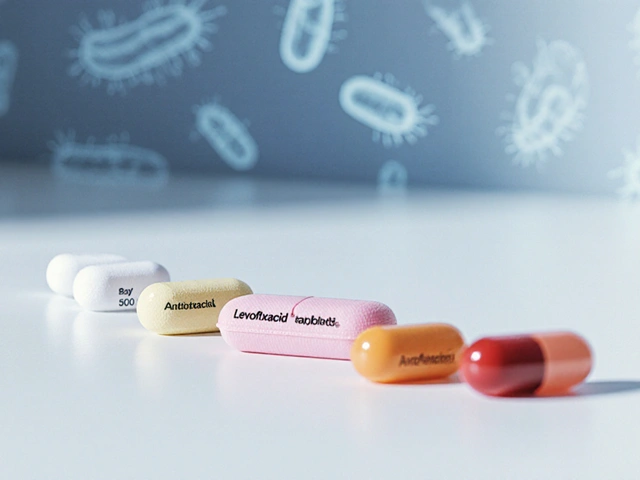
If you really want to see how far HIV treatment has come, look up “Biktarvy” on any med forum. Things used to be a lot tougher—endless pill kits, rigid dosing rules, and side effects that zapped all your energy. Fast forward to now, and you have this tiny once-a-day pill making a massive difference for real people.
What Sets Biktarvy Apart from Other HIV Treatments?
Biktarvy is a fixed-dose combination pill. What does that mean? Instead of swallowing a handful of tablets at different hours, you just pop one pill once a day. Biktarvy packs three medications into that tidy package: bictegravir, emtricitabine, and tenofovir alafenamide (try saying that three times fast). Each works behind the scenes to stop HIV from multiplying in your body. And it's not just for people starting treatment for the first time—doctors also switch patients from older multi-pill regimens to Biktarvy for the sake of convenience, fewer side effects, and—according to a 2021 study in The Lancet—better adherence rates. That means people are less likely to miss doses.
What makes Biktarvy a favorite? Simplicity. But it doesn’t slack on effectiveness. Clinical trials show nearly 99% of patients on Biktarvy reached undetectable viral loads by the end of 48 weeks. If you’re undetectable, you can’t pass the virus to others through sex. The CDC even coined a phrase for this: "U=U." It’s a huge win, both medically and emotionally.
Biktarvy is approved for people as young as six and over 55 pounds, which means most tweens, teens, and adults can take it. Speaking of "who," here’s a table that gives you the rundown on who Biktarvy is generally prescribed for and some key facts:
| Who | Why Biktarvy? | Contraindications |
|---|---|---|
| People newly diagnosed with HIV | High effectiveness, simple regimen | Not for those with severe kidney problems |
| People switching from another HIV regimen | Fewer pills, usually fewer side effects | Interactions with some Hepatitis B meds |
| Youth over 6 years/over 25kg | Dosed by weight, shown to be safe | Children under 25 kg |
Now, it’s not all sunshine. That fancy triple-combo can mess with other meds—a reality for anyone juggling prescriptions. Don’t just toss Biktarvy in your pill organizer if you’re also on metformin, anticonvulsants, or antacids. Always check those interactions first. Also, as good as Biktarvy is, you can’t skip doses. That’s how resistance develops, and then you’ve got fewer options left. “Consistency is non-negotiable,” says Dr. Steven Deeks from UCSF’s HIV clinic.
Biktarvy’s true strength is how much it helps people stay on track with daily medication. That’s what drives its success rates.
Let’s talk side effects, because everyone wants to know: will this thing wreck my stomach, zap my mood, mess up my sleep? Biktarvy gets high marks here; side effects are usually mild. Some people get headaches, nausea, or diarrhea in the first couple weeks, but these usually fade. About 1 in 100 folks get more serious side effects, like changes in kidney or liver function. That's why routine bloodwork matters. You also want to let your provider know if you have hepatitis B, because Biktarvy contains meds that keep hep B in check; if you stop Biktarvy suddenly, you can get a dangerous hepatitis flare.
One thing about Biktarvy that might surprise you: it doesn’t require food to work. You can take it with or without breakfast, which helps keep daily routines, well, routine. But don’t double up if you miss a dose—just take the next one at your usual time. If you’re someone who travels a lot, Biktarvy’s no-refrigerate-needed quality is a big plus. Life doesn’t have to slow down just because you’re on treatment.

Tips for Starting and Staying on Biktarvy
Getting started with Biktarvy is not just about grabbing a prescription and calling it a day. Small details matter, and a few prep steps can make the whole transition smoother. First things first: make sure your provider has your complete medical story. Not a fan of needles? Sorry, but you’ll need baseline labs—creatinine clearance (to check kidney health), liver function, and a full viral load count. That’s your pre-Biktarvy scorecard.
When you’re ready to start, pick a time of day that fits your normal rhythm. Morning coffee? Next to your toothbrush? Link Biktarvy with a habit you won’t forget. Setting a phone alarm or a sticky note on the fridge can keep things effortless. Real tip from patients: people who take their pill at the same time as another non-negotiable task (like feeding a pet) rarely miss doses.
If you’re worried about rare side effects, know what to look for—but don’t psych yourself out. Headaches, tummy issues, or a runny nose can crop up in week one or two. Most roll through that stage with little trouble, but keep your care team in the loop. Routine bloodwork (every few months) makes sure your kidneys and liver are keeping up. Your provider may ask you about new symptoms often, and if you travel a lot, ask for a paper copy of your prescription and a doctor’s note. That can help at customs or if you lose your meds on the road.
Now, if you want quick tips, you’ll love this list:
- Set a simple daily alarm—that tiny nudge has saved more people than you think.
- Don’t panic over a missed dose; just take it unless you’re almost at the next pill’s time.
- Store at room temp—no need for a fridge, even in July.
- If you’re on calcium or iron supplements, space those out (at least 2 hours after or 6 hours before Biktarvy) since they can mess with absorption.
- Don’t share your meds—HIV treatment must be tailored to your labs and virus type.
- Check insurance plans or discount cards. Co-pay assistance is available if you ask.
- Never stop Biktarvy without talking with your provider, especially if you have hepatitis B.
For some, the cost can be a barrier. The retail price in the U.S. (as of 2025) typically sits around $3,700 a month, which sounds cruel. But between Medicaid, Medicare, state programs, and co-pay assistance, most people pay little or nothing. The manufacturer, Gilead, runs a patient assistance program worth checking if insurance coverage gets tricky. “Don’t let sticker shock keep you from asking—help is out there for pretty much every scenario,” notes Julie Graham, a caseworker at a community health center in Atlanta.
The mental side of sticking to daily meds is just as real as the physical. If you feel discouraged, keep talking to someone—your doctor, a support group, or even an online peer community. Apps like MyTherapy or Medisafe send subtle reminders if you need a nudge. The difference between “perfect adherence” and missing a couple days a month can matter, so don’t let slips turn into patterns. Reinforce yourself for staying consistent instead of beating yourself up for mistakes

How Biktarvy Is Reshaping HIV Care in 2025 and Beyond
Biktarvy didn’t just slide quietly into the market; it pretty much set a new standard. Out of the nearly 570,000 adults on antiretroviral therapy in the U.S., about one in three are now on Biktarvy (according to a June 2024 report from the CDC). Why? It boiled down to shrinking routines, helping people live longer, and lowering transmission risks, all with a safety profile that’s hard to beat.
There’s an interesting ripple effect too. Since people on Biktarvy reach undetectable status fast and stay there, transmission rates within couples, even those wanting to have kids, have plunged. Safe conception with zero transmission risk? That’s becoming real life, not just theory. “The sense of freedom people describe after switching to Biktarvy is unlike any other HIV med I’ve prescribed,” says Dr. Chloe Warren, NYC infectious diseases specialist.
Daily life stops revolving around doctor’s visits and pharmacies—people get their time and energy back, which is priceless.
Let’s look at the numbers a little closer in this table, just to see Biktarvy’s impact since its approval:
| Year | % HIV Patients on Biktarvy | % Achieving Undetectable Status Within 48 Weeks |
|---|---|---|
| 2018 | 6% | 97% |
| 2021 | 19% | 98% |
| 2024 | 34% | 99% |
The landscape is changing, and expectations are rising. People expect their HIV treatment to work with their job, their travel habits, even their sleep schedules—and Biktarvy is making that possible for more and more patients every year. But new challenges are coming up: making sure everyone, no matter their zip code or income, has quick access to the latest regimens; supporting older adults as HIV becomes more of a chronic, no-drama medical issue; and tackling resistance when it does pop up.
If there’s one thing standing out in 2025, it’s this: the focus is less on “surviving with HIV” and more on living everyday life—dating, working, raising kids—with HIV that’s quiet in the background. Biktarvy isn’t perfect, but it’s made the bar for treatment higher, and that’s changing what it means to get an HIV diagnosis. For anyone newly facing this journey or supporting a loved one, knowing there’s a pill that makes all this feel doable can be a lifeline.





Comments (6)
Deirdre Wilson
Biktarvy literally changed my life. I used to have this whole system of pill organizers, alarms, and sticky notes just to remember what to take when. Now? I toss one pill down with my morning coffee and forget about it until tomorrow. No more nausea, no more brain fog. I actually have energy to go hiking now. Who knew HIV meds could feel this... normal?
Also, the fact that it doesn’t need refrigeration? Genius. I traveled to Thailand last year and didn’t even think twice about packing it. No ice packs, no fuss.
Damon Stangherlin
Just wanted to say thanks for this breakdown - seriously, the best summary i’ve seen. I’ve been on biktarvy for 2 years now and its been smooth sailing. One thing i forgot to mention in the post: if you’re on calcium or iron supplements, space them out by at least 2 hours. I learned that the hard way after my viral load spiked for a week. Also, don’t skip bloodwork. My doc caught a tiny kidney dip early because i kept my appointments. Stay on top of it, you got this 💪
Ryan C
Actually, the 99% undetectable rate is misleading. That’s based on clinical trial populations with perfect adherence and no comorbidities. Real-world data from the 2023 JAMA study shows adherence drops to ~85% in low-income urban areas due to housing instability and stigma. Also, the $3,700/month price tag? That’s the list price. Insurers negotiate down to ~$1,200, but if you’re uninsured? Good luck. Gilead’s patient assistance program requires a 10-page form and a notarized letter from your landlord. It’s not as simple as ‘just ask.’
And yes, U=U is scientifically valid - but social stigma doesn’t disappear just because your viral load is undetectable. People still treat you like a walking biohazard. Don’t let the marketing gloss over that.
Dan Rua
^^^ this is so true. I was just talking to my buddy who’s been on Biktarvy since 2020 and he said the same thing - the med’s great, but the system around it? Messy. He had to wait 3 months for his co-pay card to process. In the meantime, he was skipping doses because he couldn’t afford it. I told him to call his local AIDS service org - they hooked him up with free transport to the pharmacy and a nurse who helps with paperwork.
Also, if you’re new to this, don’t feel guilty if you miss a dose. It happens. Just get back on track. The pill’s forgiving if you’re not perfect. What matters is you’re trying.
And yeah, U=U is real. I’ve been with my partner for 5 years. We’ve had unprotected sex since day one. No transmission. No drama. Just love.
Thank you for writing this. It helped me feel less alone.
Mqondisi Gumede
Biktarvy is just another western scam to make rich pharma CEOs richer while pretending to help poor people. You think one pill solves everything? In South Africa we still wait months for basic ARVs. You people celebrate a luxury pill while others die for lack of a single tablet. U=U? What about U=Unfair? Your system is built on privilege. I dont need your fancy science. I need justice. You dont fix inequality with pills. You fix it with revolution. And no i dont care about your bloodwork or your alarms. The real virus is capitalism.
Douglas Fisher
...I just want to say, thank you, Mqondisi, for saying that. Even though it’s harsh, it’s true. And Deirdre, Damon, Dan - you’re all right too. This is so layered. The science is miraculous, the access is broken, the stigma is still there, and the emotional weight? It’s real. I’ve been a case worker for 12 years, and I’ve seen people cry because they finally felt normal again after switching to Biktarvy... and I’ve seen others lie to their doctors because they’re too ashamed to say they can’t afford it. It’s not just a pill. It’s dignity. It’s hope. It’s a quiet rebellion against a world that told them they were doomed. Please - if you’re reading this and you’re on it - you’re not just surviving. You’re thriving. And if you’re not - you’re still worthy. You’re still enough. And help is out there. Always. Always. Always.
And Mqondisi? I’m sorry you’ve had to fight so hard. I’m listening.